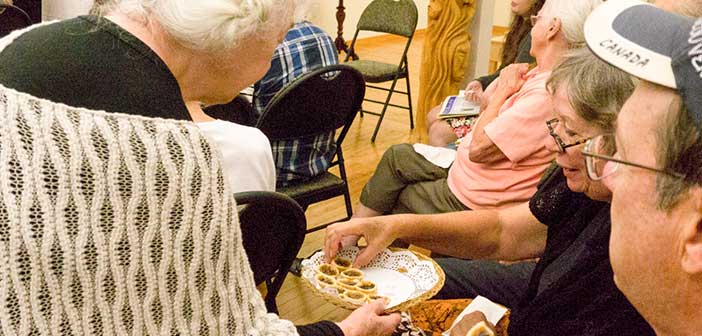GORE BAY—Last Thursday afternoon, the Gore Bay Museum, an established venue for signature cultural events on the Island, hosted two authorities on Canadian historical treasures who made fascinating presentations on aspects of our shared beginnings in this country. In “Rural Roots,” Dr. Dorothy Duncan presented “Farm Fare and Rural Recipes” and Dr. John Carter showed slides and spoke on heritage barns in “Barn Again.”
Dr. Duncan is a renowned authority on heritage foods, whose “Country Fare” columns in Century Home magazine became collectors’ item; she regaled the audience not only with tales of early foods and their preparation, but with tasty bites of those foods too. Her talk was punctuated by samples that she made herself, passed around to eager audience members, like a reception rolled right in to the lecture.
A well-travelled scholar and author who has criss-crossed the country researching food and its impact on people and the environment, Dr. Duncan began by remarking that Manitoulin is “one of the most beautiful places in Canada,” and noted that the Island served “as a highway” for early inhabitants first to trade with each other on land and water and then through the network of trading posts.
“The Odawa,” she said, “were very fine farmers who also gathered foods in seasonal movements.” The first trays of food were passed around, delicious bannock with dried cranberries on the side, from a recipe by the late powerhouse of aboriginal cultural preservation, Mary Lou Fox, founder of the Ojibwe Cultural Foundation in M’Chigeeng.
The early Irish, English and Scottish settlers brought potatoes, wheat and oats into the culinary mix, illustrated by the next trays: homemade bread, cheese and pickled leeks.
Cookbooks are so much more than recipes, insists Dr. Duncan, they reveal an entire cultural history of what we eat, the work that went into cultivating, harvesting and preparing foods and the resilience of people who “made do” under harsh conditions. Made from a recipe in “Cook Not Mad,” published in 1831, she then served cookies from the very first cookie recipe she was able to find. As listeners nibbled on the crunchy treats, Dr. Duncan spoke of the importance of fall fairs and of the Women’s Institutes; the first of these started on the Island in 1897, developing 21 branches of which seven are still active. Finally, dessert was served, in the form of tiny maple tarts with currants, with the genteel finish of Scotch mints for all.
Descriptions of Dorothy Duncan’s books, published by Dundurn Press, are found online at www.dundurn.com/authors/dorothy_duncan where they may be purchased.
Dr. John Carter, former museums advisor for the Ontario Ministry of Culture from the 1980s to his retirement last year, stripped down to his t-shirt at the start of his talk to reveal a bold graphic of a barn and the words ‘Barn Again!’ “Fifty percent of our heritage barns have disappeared,” he noted, “through fires, tornadoes, ice storms, harsh winters, lack of use and maintenance, vandalism and urban sprawl.” The earliest barns were made of logs, then squared timbers, by the settlers. “Log barns are now rare,” he added, urging everyone to document “not only barns, but rail fences” in an effort to preserve this vanishing heritage, if not the structures themselves, then at least in photographs.
Dr. Carter’s photos show unusual round, octagonal and twelve-sided structures made of boards, cut stone and fieldstone, stacked logs, and bricks; “Noah’s Ark” barns with a cupola and a second roof level descending to the first that look like cathedrals for cattle and hay; some barns were connected to a farmhouse, others used to dry tobacco or to store ice. Silos were equally inventive: first built in 1873, they were made of logs, staves, slats and concrete. A famous local landmark, the beautiful cut limestone silo on Poplar Road in Gordon Township with its dormer window in the roof, built by Scottish stonemason Stewart Clark in the 1910s or ‘20s, “will never blow down.”
As for the future, Dr. Carter showed some of the uses to which heritage barns have been turned, including working farm and agricultural museums, churches, galleries, theatres and antique shops. Anything is better, according to this barns scholar, than tearing them down or letting them become derelict. “It’s easy to tear down a barn,” he reflected, “no permit is required. If someone decides to change its use, it usually means higher taxes, which most people cannot afford. It’s expensive to restore them and there are no grants to help.” He would like to see, at minimum, a provincial repository for documentation on barns, so that this characteristic of Canada’s built heritage, and its cultural significance, are not lost forever.
An article by Dr. John Carter addressing strategies to preserve heritage barns will appear in the September issue of Acorn, the membership journal of the Architectural Conservancy of Ontario (ACO). The ACO offers complimentary one-year memberships to areas where there are no ACO branches, such as Manitoulin, which includes Acorn magazine. Visit www.arconserv.ca/Membership_Form.pdf and tick the box “New” indicating “Manitoulin Island” in your application. Tel: 416-367-8075 ext.201; email: manager@arconserv.ca; www.arconserv.ca





